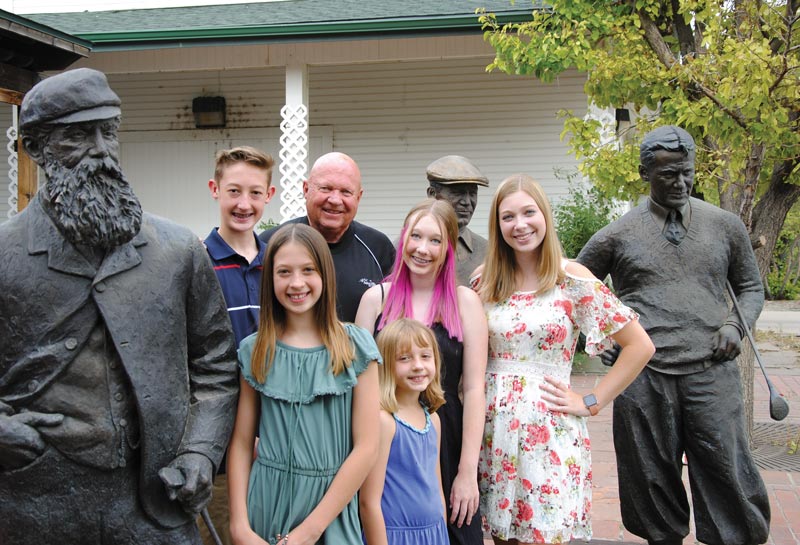
Like daily golf course maintenance, financially preparing for retirement is best begun early and addressed strategically. Dennis Lyon, CGCS, past president of GCSAA, has some advice for other members who may have questions about how to tackle it. Photos courtesy of Dennis Lyon
One thing the COVID-19 pandemic has confirmed for us all is that change is in our future. One day we arrive at the course and everything is as we left it the day before. The next day we arrive at the course and there are no employees, no golfers; the course and practically everything else in our life is shut down. Welcome to the new world of COVID-19.
There is another significant change that will be in almost everyone’s future: the transition from career employment to retirement. Whether planned years in advance or the result of a sudden change in health or employment circumstances, the day will come when you walk into your office with a box. You’ll gather up your wall plaques, photos, your valued copies of GCM and any other personal items you have and place them in your box. You’ll leave your keys on the desk, turn out the lights, pick up your box and walk out the door. Welcome to your new world, the world of retirement.
I am a Certified Golf Course Superintendent who spent 37 years working for the city of Aurora, Colo. That day came for me in December 2010, when I gathered up my box and walked out the door. Retirement’s journey for me began that day.
My story
I was hired by Aurora, Colo., in 1973 as the superintendent of the city’s only 18-hole golf course. When I retired in 2010, Aurora Golf had grown from one course to seven: six 18- hole courses and a nine-hole course. For me, Aurora Golf was a great career. During most years, my wife, Penny, and I were consumed with work, raising our family and trying to make ends meet financially. We knew virtually nothing about planning for my retirement.
Fortunately for me, Aurora has an excellent defined-benefit pension plan.
Now, after 10 years in retirement, I fully realize the impact my pension plan has had on my life. I found that when the paychecks stop, the bills keep coming. The cost of living during retirement does not decrease that much. Some costs, such as insurance and health costs, may increase.
I have found that preparing financially for retirement is critical.
Editor’s note: Author Dennis Lyons, CGCS, shares tips for solidifying your status as an employed superintendent — even in the face of economic uncertainty and an evolving job market — in Job security: 8 ways to stay indispensable.
Several years before I retired from the city, I was elected by my fellow employees to the board of directors of the Aurora Employee Retirement Plan. This involvement resulted in a significant learning opportunity for me. I spent several years engaged in an education in pension plan management and financial investment. My responsibilities resulted in my working with retirement staff and financial, legal and actuary consultants.
As a trustee, I had a fiduciary responsibility to plan members and was legally accountable for my decisions. My involvement as a plan trustee and my experience as a retiree encouraged me to write this article for GCM.
Retirement planning 101
One way to understand retirement income is to recognize the components of the three-legged retirement stool. The three-legged stool is composed of investment-generated income, Social Security, and a combination of savings and perhaps part-time employment.

Right: Lyon with Penny, his wife of 50 years.
This three-legged stool provides a balanced approach to pension financial management. If only two legs on the stool are used, such as Social Security and a small savings account, the pension stool is unstable. Although a stool in real life likely has legs of similar length, the stool in the retirement metaphor likely rests most heavily on income derived from a retirement plan.
There are two primary types of retirement plans.
1. Defined-benefit pension plan. A retirement plan in which an employer/sponsor promises a specific pension payment by a formula based on employee earnings, length of service and age.
One example of a defined-benefit plan is the plan in which I participated in Aurora. This plan provides a pension based on years employed and a salary-based contribution. All employees are required to contribute a percentage of their wages to the plan, which are matched by the city. Once an employee is qualified by age and years of service and decides to retire, their pension is calculated using a pension formula. The formula uses a multiplier, which in Aurora’s case is 1.75%. The pension is the multiplier times the number of years worked times the average of the top three years of average salary.
For example, assume an employee worked 30 years and retired with a three-year average salary of $75,000 per year. Years worked (30) multiplied by the multiplier (1.75%) multiplied by the three-year average salary ($75,000) results in a pension income of $39,375 per year, or $3,281.25 per month. This is a pension income for life, regardless of how long a retiree lives. This lifetime guarantee is one of the main advantages of a defined-benefit plan.
2. Defined-contribution retirement plan. A retirement plan in which employees contribute a fixed amount or percentage of pay to fund their retirement. Some companies will match a portion of the employee contribution as a benefit and provide investment options for their employees.
The main defined-contribution plans are a 401(k) or a 403(b) plan. The principal difference between these programs is that 401(k) plans are available to employees who are employed by for-profit companies. The 403(b) plans are for nonprofit and government employees.
These retirement plans are self-directed by the employee. The employee is generally responsible for deciding how much to contribute and how to invest contributions. An employer contribution is often an additional benefit provided to employees. If not currently available, an employer-funded retirement contribution is worth pursuing.
Individuals can start withdrawing savings from the plans upon retirement. They can withdraw funds until the balance reaches zero. This plan requires a calculation to determine the amount of money to invest during one’s career in order to withdraw the monthly desired retirement pension for a determined number of years. (See “Defined-contribution pension calculator,” below).
Retirement is similar to unemployment
While conducting research for this article, I came across a USA Today article in the personal finance section with a headline that read, “Retirement is akin to unemployment.”
In this article, USA Today reported:
- According to a Northwestern Mutual study, only 16% of adults surveyed had saved $200,000 or more for retirement.
- One in five Americans has saved less than $5,000, and 15% have no retirement savings at all.
- However, 57% of working Americans expect to retire comfortably.
- The average life span in the U.S. is 78.7 years. For those who stop working in their 60s, retirement is indeed like nearly 20 years of unemployment.
GCSAA members, based on a member survey in 2016, are in better shape than the public described in the USA Today article. According to this survey:
- 95% of GCSAA members who responded are saving for retirement. However, 52% intend to continue working beyond their normal retirement age.
- 88% said financial issues are a common cause of work-life stress and are supportive of GCSAA providing information to assist them in financial planning for their future.
- The members’ preference is to receive this information electronically — by email and newsletter, and from a retirement-oriented platform on GCSAA’s website.
- 80% of responding members are interested in GCSAA offering a member retirement financial planning service if these services are provided at a discount.
What retirement really is
As you contemplate the transition from full-time employment to retirement, the question, “What really is retirement?” might come up.
- Is retirement watching an early morning sunrise with a cup of coffee and knowing the rest of the day is all yours?
- Is it a round of golf with friends, a good book, or perhaps a pleasant walk with no stress or worries?
- Is it volunteering for a nonprofit and filling available time with travel?
- Does retirement include a part-time job at the course up the street?
These situations, and many others, can be the beauty of retirement and the dream of what retirement could be. This dream is, however, dependent on retirement finances and the investments and actions taken well in advance of retirement. Retirement and its financial implications are in almost everyone’s future. Therefore, a retirement income financial plan needs to be established early and implemented throughout one’s career. Expertise and advice on financial planning are available to help investors make the right decisions when implementing their plan.

In retirement, Lyon has been able to concentrate on his “2G Network”: golf and grandchildren.
Currently, most GCSAA members are dependent on their employer and themselves to finance and implement a financial retirement plan. However, in keeping with the vision of GCSAA founder Col. John Morley that “GCSAA was founded on justice, brotherhood and generous benevolence,” it is also a reasonable goal for GCSAA to eventually offer members advice and support in retirement financial planning. Hopefully, GCSAA will eventually develop a relationship with a company dedicated specifically to working with association members on their investments and planning for their financial futures.
My thoughts are, investing in a retirement plan is a lot like planting a tree. The best time to plant a tree is 20 years ago. The second-best time to plant a tree is today. If you have not already begun contributing to a retirement plan, the best time is right now.
Here’s hoping your retirement future is filled with happiness and financial success. I hope that someday you too can participate in something like what I call the “2G Network.” My 2G Network is composed of golf and grandkids.
Defined-contribution pension calculator
There are many ways to calculate retirement contributions and returns. Each individual needs to generate their own information for calculation purposes. The following information was based on assumptions I used on a Vanguard retirement calculator, which is a hypothetical illustration to demonstrate the advantage of saving early for retirement. Regardless of which calculator you use, the underlying principle is the same: The earlier you start to save for retirement, the better.
Assumptions:
- Current age: 30
- Anticipated retirement age: 70
- Annual salary: $75,000
- Desired pension income from investments: $2,000/month for a typical remaining life span, to be combined with Social Security income and any other investments
- Assume 7% annual return on investments.
The monthly payroll contribution required at age 30 to achieve $2,000 per month at age 70 is $6,500 per year, or $542 per month.
However, increasing current age from 30 to 45 increases the monthly contribution from $542 to $1,167, underscoring the importance of starting any retirement plan early in one’s career.
Dennis Lyon, CGCS, is a retired superintendent and has spent 15 years as a trustee in two different defined-benefit pension plans. A 47-year association member, Lyon was GCSAA’s president in 1989 and received GCSAA’s Col. John Morley Distinguished Service Award in 2013.